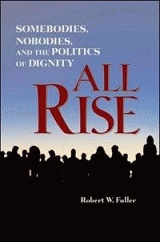by Berrett-Koehler, 2006
This is the fourth part of the serialization of All Rise: Somebodies, Nobodies, and the Politics of Dignity (Berrett-Koehler, 2006). The ideas in this book are further developed in my recent novel The Rowan Tree.
Chapter 3: MODELS OF DIGNITY
When first we mean to build,
We first survey the plot, then draw the model.
--William Shakespeare, Henry IV
The sciences do not try to explain, they hardly even try to interpret, they mainly make models. By a model is meant a...construct which, with the addition of certain verbal interpretations, describes observed phenomena. The justification of such a construct is solely and precisely that it is expected to work.
--John von Neumann, digital computer logician and creator of game theory
We Are Model Builders
The title of Mark Twain's What Is Man? poses a question that humankind has pondered for millennia. Over time, the species that scientists call Homo sapiens (the wise) has also variously been referred to as Homo faber (the builder, by Benjamin Franklin), Homo ludens (the game player, by Johan Huizinga), Homo economicus (the rationalist, by Adam Smith), and Homo babulus (the talker). Twain himself argued that man is a machine (Homo machinus).
While all of the above describe us, none does so uniquely. In fact, it seems that every time someone makes a case that a particular trait sets humans apart, experts in animal life say, "No, animals do that too."
Animals display intelligence, they build things (nests, dams) and use tools, they play games, make war, communicate, and have emotions.
Nonetheless, there is one faculty that humans appear to have developed more than other animals. It is our talent for consciously building models that represent nature, ourselves, and our institutions. Many of our models, both historically and today, take the form of narratives.
Cooperating across the generations on the development of models and passing on our stories have combined to give our species a dominant role on this planet.
Model building, in combination with complex language, stands as one of humankind's epochal accomplishments. It's the faculty that has enabled us to harness nature's force. The flip side of this is that we often use these powers in ways that cause others indignity. But the modeling skills that have put power in our hands can also help guide us toward dignity-protecting applications of that power. The following paragraphs illustrate some of the key features of model building that will be used throughout this book.
Models Are Everywhere
People learn modeling early, starting with Play Doh, Lego blocks, dolls, and model trains. The stories we grow up with are replete with models of human behavior. Teens today fancy themselves as video game characters and get to try out different behaviors vicariously, without risking their own lives or even punishment for "failure."
Scientists Francis Crick and James Watson modeled the double-stranded helical structure of the DNA molecule with Tinkertoys. There is a model of the San Francisco Bay--complete with miniature piers poking into the water, a scaled-down Golden Gate Bridge, and "tidal currents" propelled by pumps--that fills a warehouse in Sausalito, California.
By studying it, scientists can anticipate the effects of proposed real-world alterations of the bay. Similarly, to protect Venice, Italy, from the rising sea, engineers use a model of the adjoining lagoon and gulf. Using computers and mathematical models, weather bureaus the world over provide forecasts. As everyone knows, the predictions are not always right, but they're getting more accurate as the models upon which they are based improve.
Experimenting with model planes in wind tunnels enabled the Wright brothers to build the aircraft they flew at Kitty Hawk a century ago. Even more significant than the plane they built was their pioneering use of modeling in engineering. Models enabled them to anticipate problems through trial and error without paying the price of crashing a piloted plane. Today, flight can be simulated on computers by representing both the airplane and the atmosphere in a mathematical model.
Grand unifying models are the holy grail of every branch of science. In biology, Darwin's theory of evolution by natural selection is such a model. In chemistry, it's Mendeleyev's periodic table of the elements. In geology, plate tectonics accounts for all the earth's principal geological features.
Present-day physicists are searching for a "theory of everything" that would incorporate all known forces. "We hope to explain the entire universe in a single, simple formula that you can wear on your T-shirt," says Leon Lederman, a Nobel laureate in physics. One candidate model, now under development, is string theory. Like all theories and models,string theory will ultimately live or die "solely and precisely," as stated in the von Neumann quotation at the beginning of this chapter, on whether its implications agree with observations.
Next Page 1 | 2 | 3 | 4 | 5 | 6
(Note: You can view every article as one long page if you sign up as an Advocate Member, or higher).





